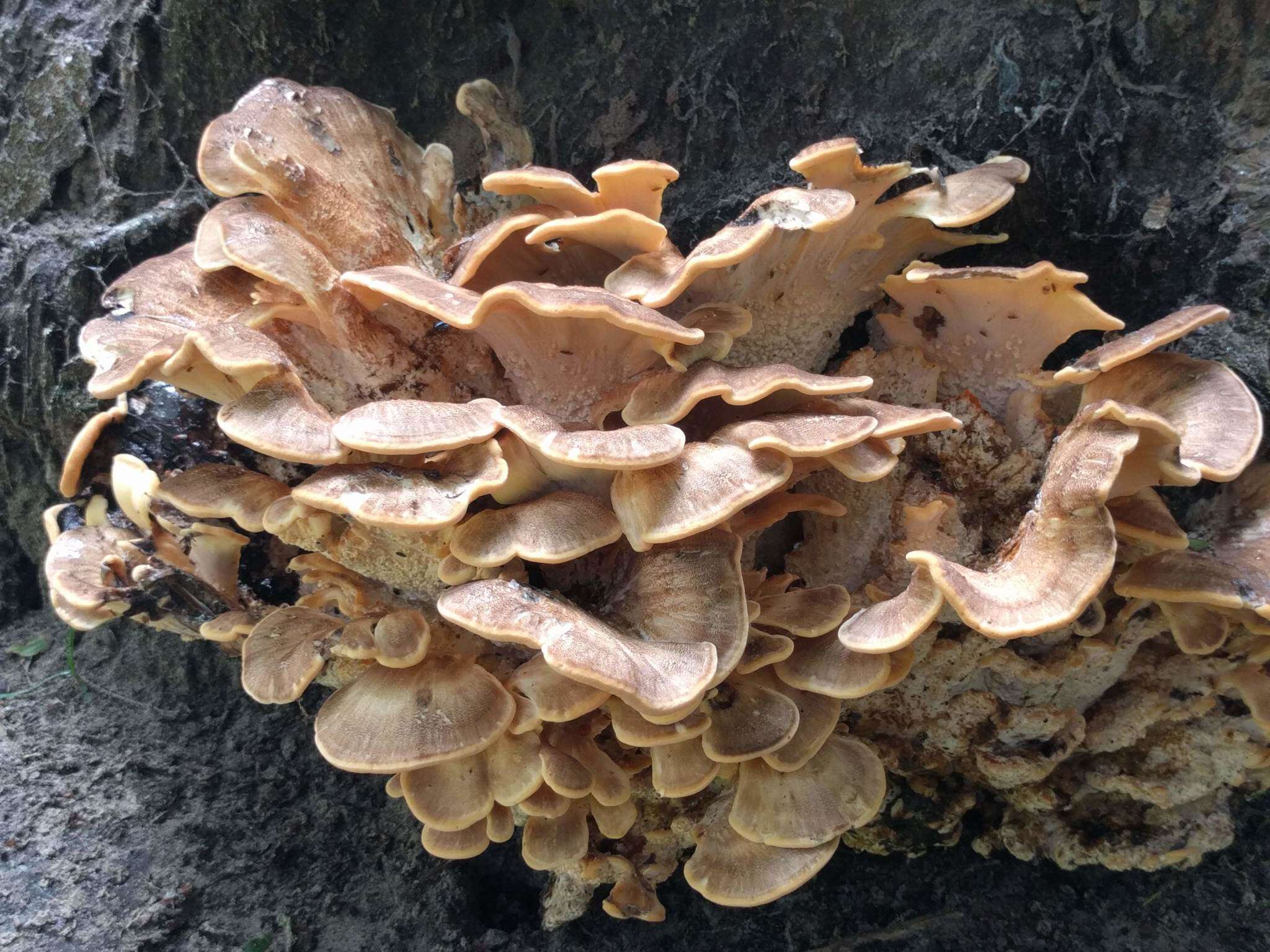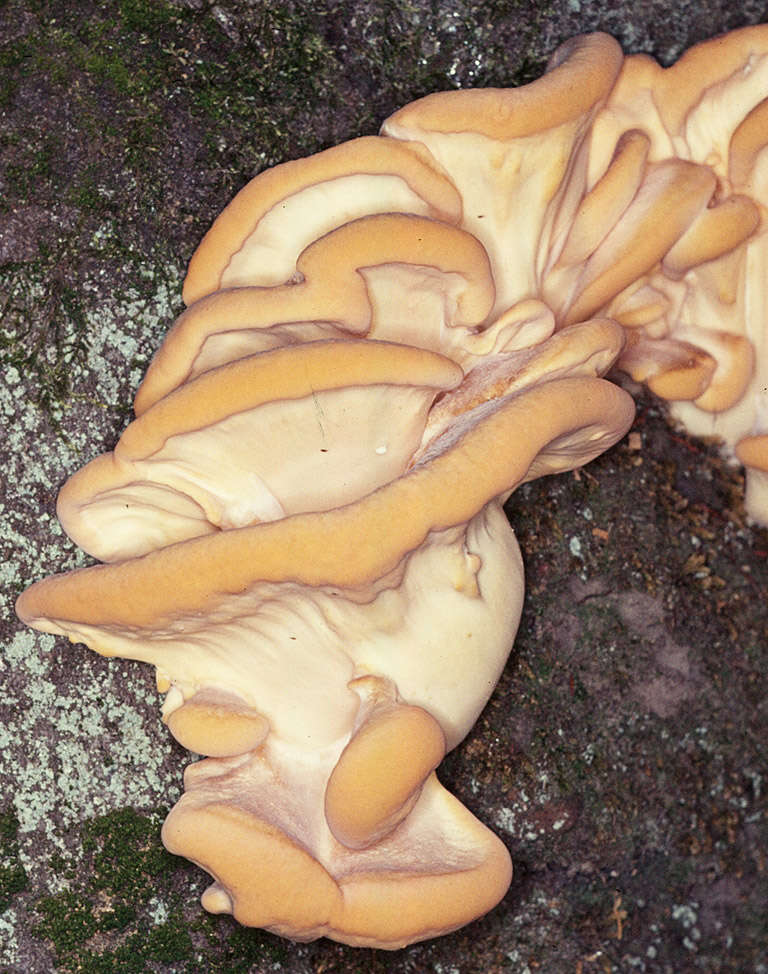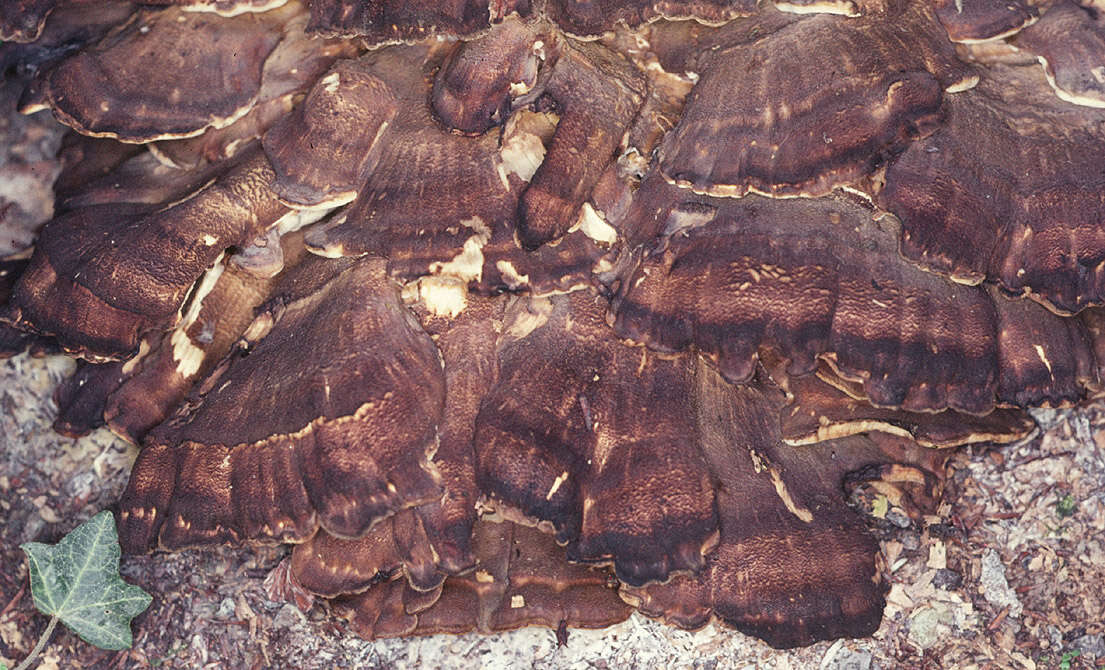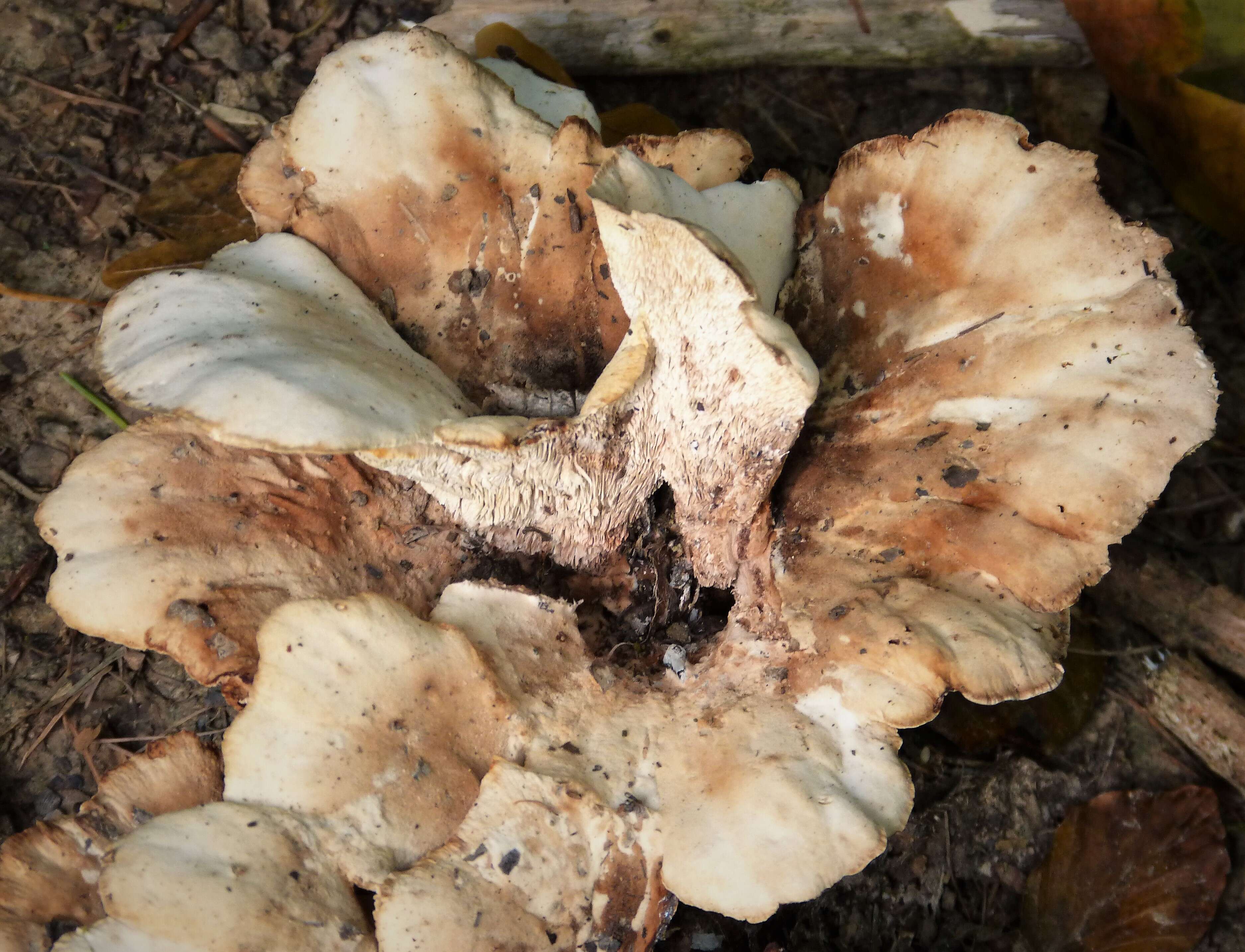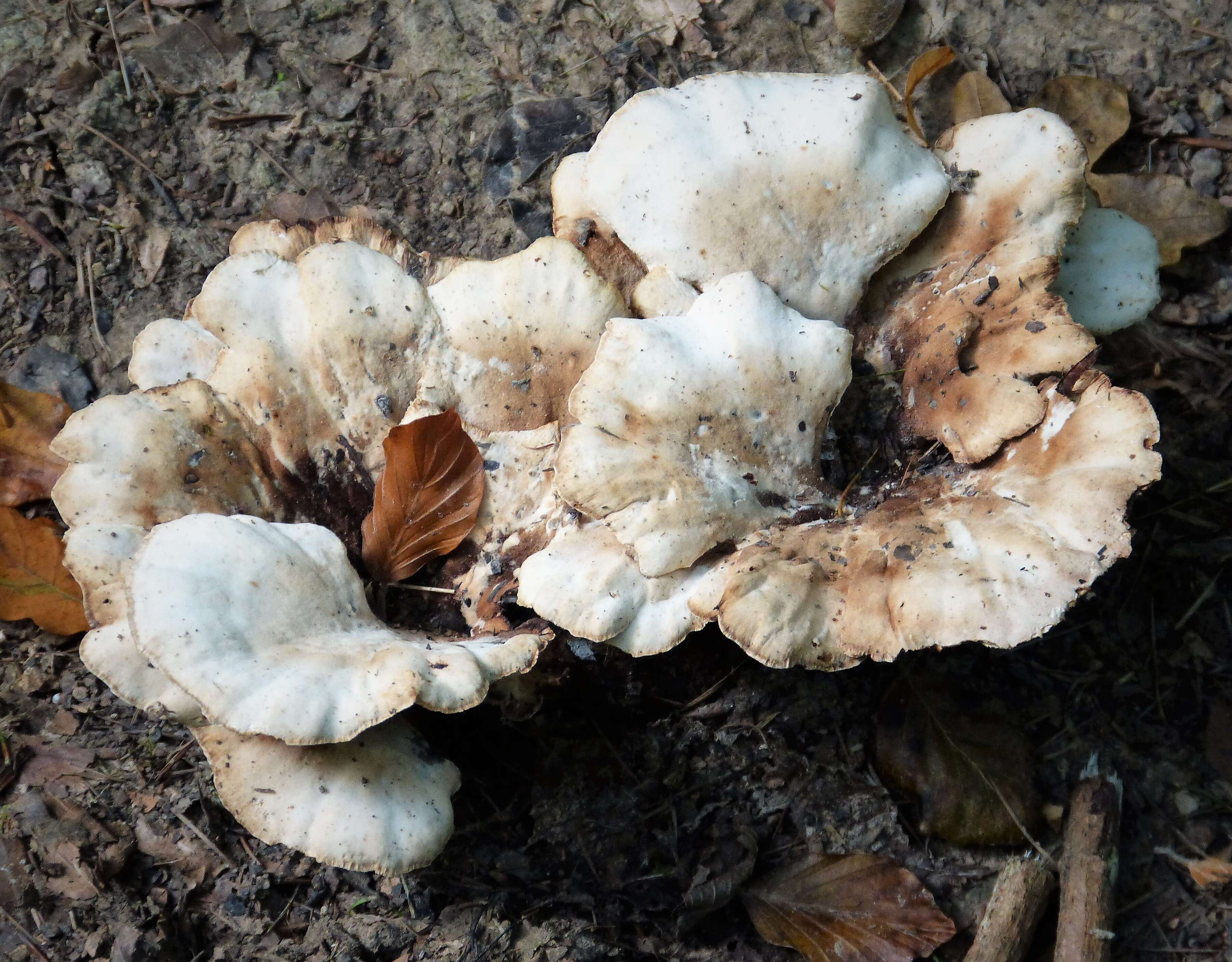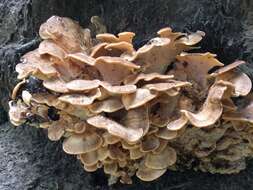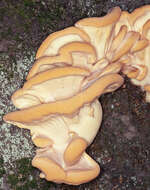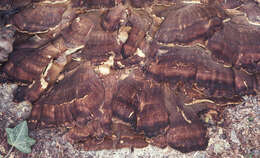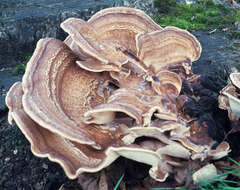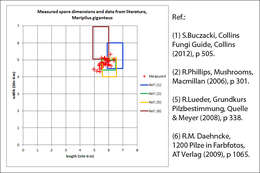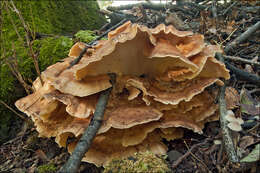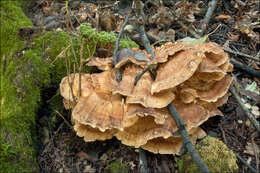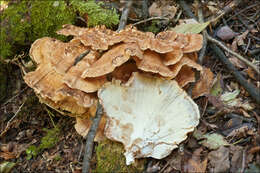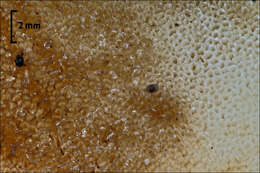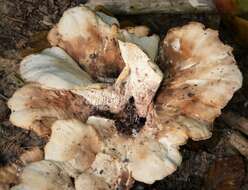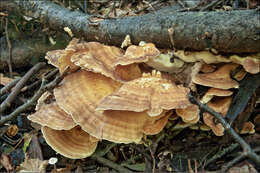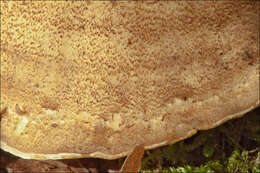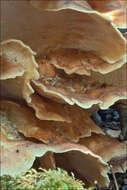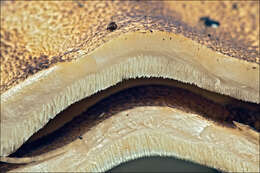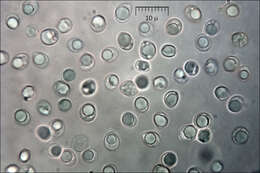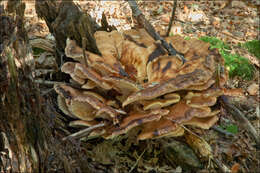-
-
Longitude (deg): -0.7. Latitude (deg): 51.0. Longitude (deg/min): 0° 40' W. Latitude (deg/min): 51° 10' N. Vice county name: Surrey. Vice county no.: 17. Country: England. Stage: Fruitbody. Identified by: Malcolm Storey. Category: standard photograph or close-up. Photographic equipment used: "35mm transparencies (on a variety of films, but Agfa CT18 in the 1960's to early 1980's followed by Fujichrome in the late 1980's.) Transparencies scanned with Minolta Dimage Scan Dual II AF-2820U transparency scanner.".
-
Longitude (deg): -0.7. Latitude (deg): 51.0. Longitude (deg/min): 0° 40' W. Latitude (deg/min): 51° 10' N. Vice county name: Surrey. Vice county no.: 17. Country: England. Stage: Fruitbody. Identified by: Malcolm Storey. Category: standard photograph or close-up. Photographic equipment used: "35mm transparencies (on a variety of films, but Agfa CT18 in the 1960's to early 1980's followed by Fujichrome in the late 1980's.) Transparencies scanned with Minolta Dimage Scan Dual II AF-2820U transparency scanner.".
-
Longitude (deg): 1.2. Latitude (deg): 52.6. Longitude (deg/min): 1° 10' E. Latitude (deg/min): 52° 40' N. Vice county name: East Norfolk. Vice county no.: 27. Country: England. Stage: Fruitbody. Identified by: Malcolm Storey. Comment: on half-buried stump in lawn. Category: standard photograph or close-up. Photographic equipment used: "35mm transparencies (on a variety of films, but Agfa CT18 in the 1960's to early 1980's followed by Fujichrome in the late 1980's.) Transparencies scanned with Minolta Dimage Scan Dual II AF-2820U transparency scanner.".
-

Meripilus giganteusGiant PolyporeSlo.: rnea velezraenkaDat.: Sept. 19. 2013Lat.: 46.33515 Long.: 13.56790Code: Bot_750/2013_DSC0349Habitat: Light, mixed, predominantly hardwood woodland, dominant Fagus sylvatica, Picea abies, Quercus sp., Fraxinus excelsior, Corylus avellana; nearly flat terrain, cretaceous clastic rock (flysh), partly rain protected by trees canopies, mostly in shade, precipitations ~3.000 mm/year, average temperature 8-10 deg C, elevation 480 m (1.575feet), alpine phytogeographical region.Substratum: a large stump and roots of a cut down tree in its final stage of disintegration; tree species undistinguishable; most probably Fagus sylvatica, but possibly also Quercus sp. (several trees growing in the vicinity).Place: Bovec basin, Humi hill, East Julian Alps, Posoje, Slovenia EC Comments: Growing solitary (probably a single mycelium), however in three groups of pilei on the same tree; they were about 1 m (3 feet) apart, the largest group about 40 cm (16 inch) in diameter; taste strong, mushroomy, unpleasant; smell slightly unpleasant, indistinctive; flesh strongly fibrous; SP whitish; pore surface bruising when handled, first ochre, then brown, then blackish, but not fast, the process takes several ten minutes.Spores smooth. Dimensions: 5.7 (SD= 0.3) x 4.8 (SD= 0.2) , Q= 1.2 (SD= 0.06), n= 30. Olympus CH20, NEA 100x/1.25, magnification 1.000 x, oil, in water.AmScope MA500 digital camera.Herbarium: Mycotheca and lichen herbarium (LJU-Li) of Slovenian Forestry Institute, Vena pot 2, Ljubljana, Index Herbariorum LJFRef.:(1) S.Buczacki, Collins Fungi Guide, Collins (2012), p 505.(2) R.Phillips, Mushrooms, Macmillan (2006), p 301.(3) G.J.Krieglsteiner (Hrsg.), Die Grosspilze Baden-Wrttembergs, Band 1, Ulmer (2000), p 547. (4) M.Bon, Parey'sBuch der Pilze, Kosmos (2005), p 314. (5) R.Lueder, Grundkurs Pilzbestimmung, Quelle& Meyer (2008), p 338.(6). Daehncke, 1200 Pilze in Farbfotos, AT Verlag (2009), p 1065.
-
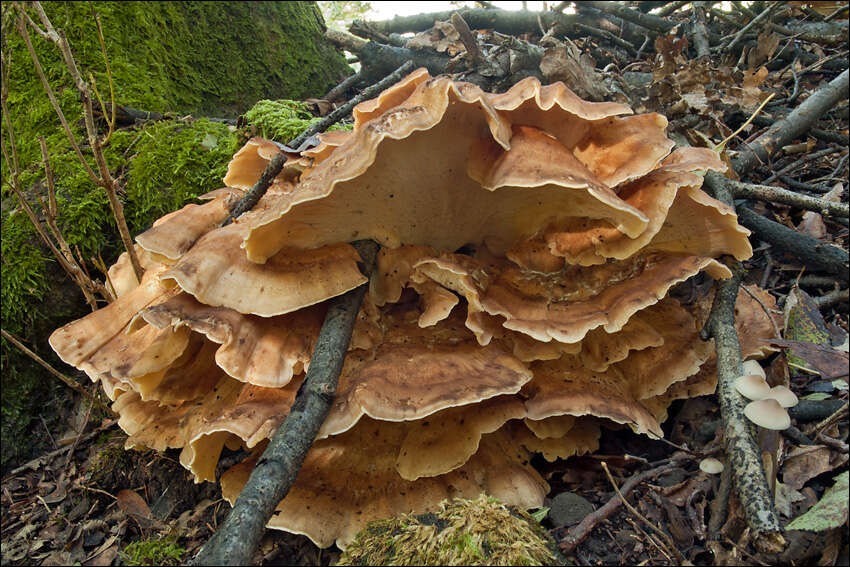
Meripilus giganteusGiant PolyporeSlo.: rnea velezraenkaDat.: Sept. 19. 2013Lat.: 46.33515 Long.: 13.56790Code: Bot_750/2013_DSC0349Habitat: Light, mixed, predominantly hardwood woodland, dominant Fagus sylvatica, Picea abies, Quercus sp., Fraxinus excelsior, Corylus avellana; nearly flat terrain, cretaceous clastic rock (flysh), partly rain protected by trees canopies, mostly in shade, precipitations ~3.000 mm/year, average temperature 8-10 deg C, elevation 480 m (1.575feet), alpine phytogeographical region.Substratum: a large stump and roots of a cut down tree in its final stage of disintegration; tree species undistinguishable; most probably Fagus sylvatica, but possibly also Quercus sp. (several trees growing in the vicinity).Place: Bovec basin, Humi hill, East Julian Alps, Posoje, Slovenia EC Comments: Growing solitary (probably a single mycelium), however in three groups of pilei on the same tree; they were about 1 m (3 feet) apart, the largest group about 40 cm (16 inch) in diameter; taste strong, mushroomy, unpleasant; smell slightly unpleasant, indistinctive; flesh strongly fibrous; SP whitish; pore surface bruising when handled, first ochre, then brown, then blackish, but not fast, the process takes several ten minutes.Spores smooth. Dimensions: 5.7 (SD= 0.3) x 4.8 (SD= 0.2) , Q= 1.2 (SD= 0.06), n= 30. Olympus CH20, NEA 100x/1.25, magnification 1.000 x, oil, in water.AmScope MA500 digital camera.Herbarium: Mycotheca and lichen herbarium (LJU-Li) of Slovenian Forestry Institute, Vena pot 2, Ljubljana, Index Herbariorum LJFRef.:(1) S.Buczacki, Collins Fungi Guide, Collins (2012), p 505.(2) R.Phillips, Mushrooms, Macmillan (2006), p 301.(3) G.J.Krieglsteiner (Hrsg.), Die Grosspilze Baden-Wrttembergs, Band 1, Ulmer (2000), p 547. (4) M.Bon, Parey'sBuch der Pilze, Kosmos (2005), p 314. (5) R.Lueder, Grundkurs Pilzbestimmung, Quelle& Meyer (2008), p 338.(6). Daehncke, 1200 Pilze in Farbfotos, AT Verlag (2009), p 1065.
-
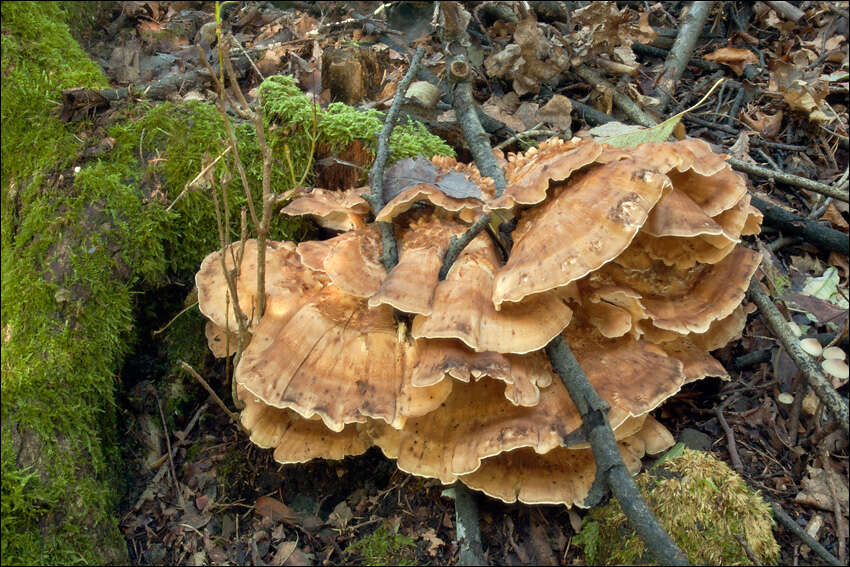
Meripilus giganteusGiant PolyporeSlo.: rnea velezraenkaDat.: Sept. 19. 2013Lat.: 46.33515 Long.: 13.56790Code: Bot_750/2013_DSC0349Habitat: Light, mixed, predominantly hardwood woodland, dominant Fagus sylvatica, Picea abies, Quercus sp., Fraxinus excelsior, Corylus avellana; nearly flat terrain, cretaceous clastic rock (flysh), partly rain protected by trees canopies, mostly in shade, precipitations ~3.000 mm/year, average temperature 8-10 deg C, elevation 480 m (1.575feet), alpine phytogeographical region.Substratum: a large stump and roots of a cut down tree in its final stage of disintegration; tree species undistinguishable; most probably Fagus sylvatica, but possibly also Quercus sp. (several trees growing in the vicinity).Place: Bovec basin, Humi hill, East Julian Alps, Posoje, Slovenia EC Comments: Growing solitary (probably a single mycelium), however in three groups of pilei on the same tree; they were about 1 m (3 feet) apart, the largest group about 40 cm (16 inch) in diameter; taste strong, mushroomy, unpleasant; smell slightly unpleasant, indistinctive; flesh strongly fibrous; SP whitish; pore surface bruising when handled, first ochre, then brown, then blackish, but not fast, the process takes several ten minutes.Spores smooth. Dimensions: 5.7 (SD= 0.3) x 4.8 (SD= 0.2) , Q= 1.2 (SD= 0.06), n= 30. Olympus CH20, NEA 100x/1.25, magnification 1.000 x, oil, in water.AmScope MA500 digital camera.Herbarium: Mycotheca and lichen herbarium (LJU-Li) of Slovenian Forestry Institute, Vena pot 2, Ljubljana, Index Herbariorum LJFRef.:(1) S.Buczacki, Collins Fungi Guide, Collins (2012), p 505.(2) R.Phillips, Mushrooms, Macmillan (2006), p 301.(3) G.J.Krieglsteiner (Hrsg.), Die Grosspilze Baden-Wrttembergs, Band 1, Ulmer (2000), p 547. (4) M.Bon, Parey'sBuch der Pilze, Kosmos (2005), p 314. (5) R.Lueder, Grundkurs Pilzbestimmung, Quelle& Meyer (2008), p 338.(6). Daehncke, 1200 Pilze in Farbfotos, AT Verlag (2009), p 1065.
-

Meripilus giganteusGiant PolyporeSlo.: rnea velezraenkaDat.: Sept. 19. 2013Lat.: 46.33515 Long.: 13.56790Code: Bot_750/2013_DSC0349Habitat: Light, mixed, predominantly hardwood woodland, dominant Fagus sylvatica, Picea abies, Quercus sp., Fraxinus excelsior, Corylus avellana; nearly flat terrain, cretaceous clastic rock (flysh), partly rain protected by trees canopies, mostly in shade, precipitations ~3.000 mm/year, average temperature 8-10 deg C, elevation 480 m (1.575feet), alpine phytogeographical region.Substratum: a large stump and roots of a cut down tree in its final stage of disintegration; tree species undistinguishable; most probably Fagus sylvatica, but possibly also Quercus sp. (several trees growing in the vicinity).Place: Bovec basin, Humi hill, East Julian Alps, Posoje, Slovenia EC Comments: Growing solitary (probably a single mycelium), however in three groups of pilei on the same tree; they were about 1 m (3 feet) apart, the largest group about 40 cm (16 inch) in diameter; taste strong, mushroomy, unpleasant; smell slightly unpleasant, indistinctive; flesh strongly fibrous; SP whitish; pore surface bruising when handled, first ochre, then brown, then blackish, but not fast, the process takes several ten minutes.Spores smooth. Dimensions: 5.7 (SD= 0.3) x 4.8 (SD= 0.2) , Q= 1.2 (SD= 0.06), n= 30. Olympus CH20, NEA 100x/1.25, magnification 1.000 x, oil, in water.AmScope MA500 digital camera.Herbarium: Mycotheca and lichen herbarium (LJU-Li) of Slovenian Forestry Institute, Vena pot 2, Ljubljana, Index Herbariorum LJFRef.:(1) S.Buczacki, Collins Fungi Guide, Collins (2012), p 505.(2) R.Phillips, Mushrooms, Macmillan (2006), p 301.(3) G.J.Krieglsteiner (Hrsg.), Die Grosspilze Baden-Wrttembergs, Band 1, Ulmer (2000), p 547. (4) M.Bon, Parey'sBuch der Pilze, Kosmos (2005), p 314. (5) R.Lueder, Grundkurs Pilzbestimmung, Quelle& Meyer (2008), p 338.(6). Daehncke, 1200 Pilze in Farbfotos, AT Verlag (2009), p 1065.
-
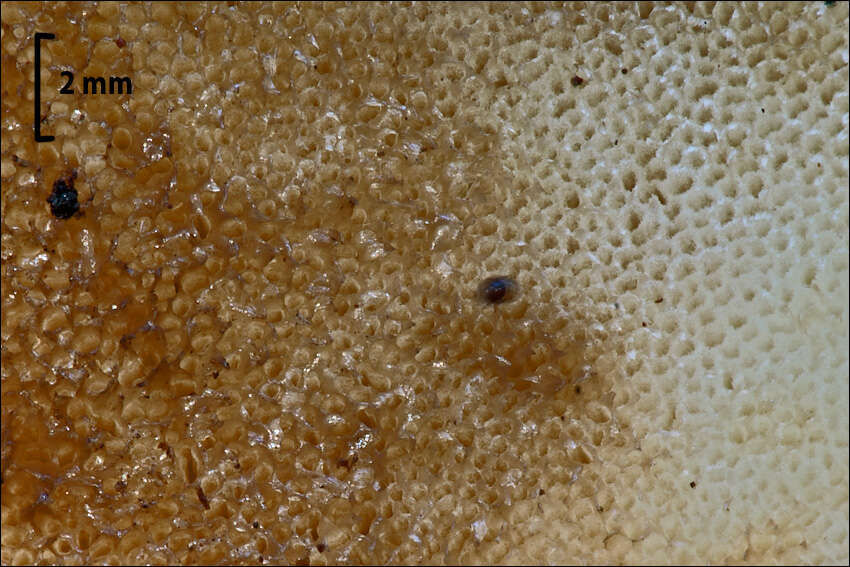
Meripilus giganteusGiant PolyporeSlo.: rnea velezraenkaDat.: Sept. 19. 2013Lat.: 46.33515 Long.: 13.56790Code: Bot_750/2013_DSC0349Habitat: Light, mixed, predominantly hardwood woodland, dominant Fagus sylvatica, Picea abies, Quercus sp., Fraxinus excelsior, Corylus avellana; nearly flat terrain, cretaceous clastic rock (flysh), partly rain protected by trees canopies, mostly in shade, precipitations ~3.000 mm/year, average temperature 8-10 deg C, elevation 480 m (1.575feet), alpine phytogeographical region.Substratum: a large stump and roots of a cut down tree in its final stage of disintegration; tree species undistinguishable; most probably Fagus sylvatica, but possibly also Quercus sp. (several trees growing in the vicinity).Place: Bovec basin, Humi hill, East Julian Alps, Posoje, Slovenia EC Comments: Growing solitary (probably a single mycelium), however in three groups of pilei on the same tree; they were about 1 m (3 feet) apart, the largest group about 40 cm (16 inch) in diameter; taste strong, mushroomy, unpleasant; smell slightly unpleasant, indistinctive; flesh strongly fibrous; SP whitish; pore surface bruising when handled, first ochre, then brown, then blackish, but not fast, the process takes several ten minutes.Spores smooth. Dimensions: 5.7 (SD= 0.3) x 4.8 (SD= 0.2) , Q= 1.2 (SD= 0.06), n= 30. Olympus CH20, NEA 100x/1.25, magnification 1.000 x, oil, in water.AmScope MA500 digital camera.Herbarium: Mycotheca and lichen herbarium (LJU-Li) of Slovenian Forestry Institute, Vena pot 2, Ljubljana, Index Herbariorum LJFRef.:(1) S.Buczacki, Collins Fungi Guide, Collins (2012), p 505.(2) R.Phillips, Mushrooms, Macmillan (2006), p 301.(3) G.J.Krieglsteiner (Hrsg.), Die Grosspilze Baden-Wrttembergs, Band 1, Ulmer (2000), p 547. (4) M.Bon, Parey'sBuch der Pilze, Kosmos (2005), p 314. (5) R.Lueder, Grundkurs Pilzbestimmung, Quelle& Meyer (2008), p 338.(6). Daehncke, 1200 Pilze in Farbfotos, AT Verlag (2009), p 1065.
-
SO557146. Forest of Dean Gloucestershire
-
SO557146. Forest of Dean Gloucestershire
-
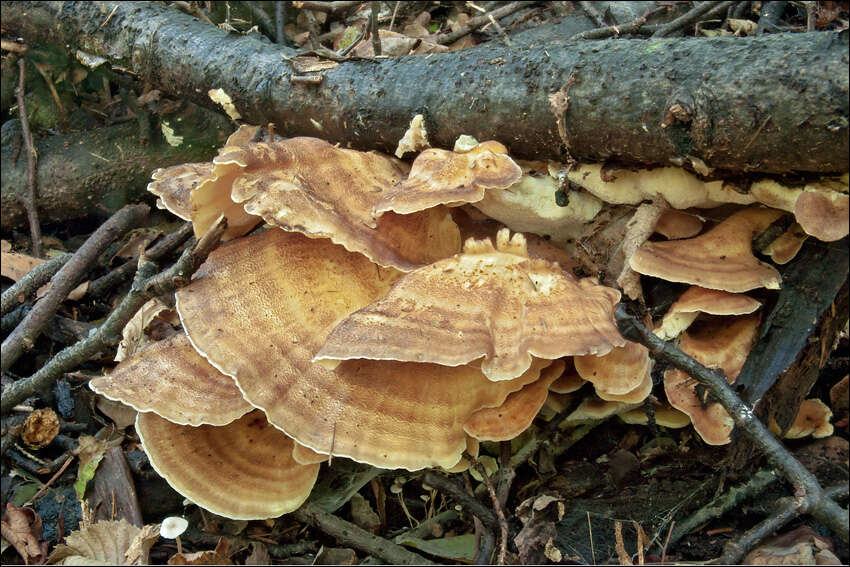
Meripilus giganteusGiant PolyporeSlo.: rnea velezraenkaDat.: Sept. 19. 2013Lat.: 46.33515 Long.: 13.56790Code: Bot_750/2013_DSC0349Habitat: Light, mixed, predominantly hardwood woodland, dominant Fagus sylvatica, Picea abies, Quercus sp., Fraxinus excelsior, Corylus avellana; nearly flat terrain, cretaceous clastic rock (flysh), partly rain protected by trees canopies, mostly in shade, precipitations ~3.000 mm/year, average temperature 8-10 deg C, elevation 480 m (1.575feet), alpine phytogeographical region.Substratum: a large stump and roots of a cut down tree in its final stage of disintegration; tree species undistinguishable; most probably Fagus sylvatica, but possibly also Quercus sp. (several trees growing in the vicinity).Place: Bovec basin, Humi hill, East Julian Alps, Posoje, Slovenia EC Comments: Growing solitary (probably a single mycelium), however in three groups of pilei on the same tree; they were about 1 m (3 feet) apart, the largest group about 40 cm (16 inch) in diameter; taste strong, mushroomy, unpleasant; smell slightly unpleasant, indistinctive; flesh strongly fibrous; SP whitish; pore surface bruising when handled, first ochre, then brown, then blackish, but not fast, the process takes several ten minutes.Spores smooth. Dimensions: 5.7 (SD= 0.3) x 4.8 (SD= 0.2) , Q= 1.2 (SD= 0.06), n= 30. Olympus CH20, NEA 100x/1.25, magnification 1.000 x, oil, in water.AmScope MA500 digital camera.Herbarium: Mycotheca and lichen herbarium (LJU-Li) of Slovenian Forestry Institute, Vena pot 2, Ljubljana, Index Herbariorum LJFRef.:(1) S.Buczacki, Collins Fungi Guide, Collins (2012), p 505.(2) R.Phillips, Mushrooms, Macmillan (2006), p 301.(3) G.J.Krieglsteiner (Hrsg.), Die Grosspilze Baden-Wrttembergs, Band 1, Ulmer (2000), p 547. (4) M.Bon, Parey'sBuch der Pilze, Kosmos (2005), p 314. (5) R.Lueder, Grundkurs Pilzbestimmung, Quelle& Meyer (2008), p 338.(6). Daehncke, 1200 Pilze in Farbfotos, AT Verlag (2009), p 1065.
-

Meripilus giganteusGiant PolyporeSlo.: rnea velezraenkaDat.: Sept. 19. 2013Lat.: 46.33515 Long.: 13.56790Code: Bot_750/2013_DSC0349Habitat: Light, mixed, predominantly hardwood woodland, dominant Fagus sylvatica, Picea abies, Quercus sp., Fraxinus excelsior, Corylus avellana; nearly flat terrain, cretaceous clastic rock (flysh), partly rain protected by trees canopies, mostly in shade, precipitations ~3.000 mm/year, average temperature 8-10 deg C, elevation 480 m (1.575feet), alpine phytogeographical region.Substratum: a large stump and roots of a cut down tree in its final stage of disintegration; tree species undistinguishable; most probably Fagus sylvatica, but possibly also Quercus sp. (several trees growing in the vicinity).Place: Bovec basin, Humi hill, East Julian Alps, Posoje, Slovenia EC Comments: Growing solitary (probably a single mycelium), however in three groups of pilei on the same tree; they were about 1 m (3 feet) apart, the largest group about 40 cm (16 inch) in diameter; taste strong, mushroomy, unpleasant; smell slightly unpleasant, indistinctive; flesh strongly fibrous; SP whitish; pore surface bruising when handled, first ochre, then brown, then blackish, but not fast, the process takes several ten minutes.Spores smooth. Dimensions: 5.7 (SD= 0.3) x 4.8 (SD= 0.2) , Q= 1.2 (SD= 0.06), n= 30. Olympus CH20, NEA 100x/1.25, magnification 1.000 x, oil, in water.AmScope MA500 digital camera.Herbarium: Mycotheca and lichen herbarium (LJU-Li) of Slovenian Forestry Institute, Vena pot 2, Ljubljana, Index Herbariorum LJFRef.:(1) S.Buczacki, Collins Fungi Guide, Collins (2012), p 505.(2) R.Phillips, Mushrooms, Macmillan (2006), p 301.(3) G.J.Krieglsteiner (Hrsg.), Die Grosspilze Baden-Wrttembergs, Band 1, Ulmer (2000), p 547. (4) M.Bon, Parey'sBuch der Pilze, Kosmos (2005), p 314. (5) R.Lueder, Grundkurs Pilzbestimmung, Quelle& Meyer (2008), p 338.(6). Daehncke, 1200 Pilze in Farbfotos, AT Verlag (2009), p 1065.
-

Meripilus giganteusGiant PolyporeSlo.: rnea velezraenkaDat.: Sept. 19. 2013Lat.: 46.33515 Long.: 13.56790Code: Bot_750/2013_DSC0349Habitat: Light, mixed, predominantly hardwood woodland, dominant Fagus sylvatica, Picea abies, Quercus sp., Fraxinus excelsior, Corylus avellana; nearly flat terrain, cretaceous clastic rock (flysh), partly rain protected by trees canopies, mostly in shade, precipitations ~3.000 mm/year, average temperature 8-10 deg C, elevation 480 m (1.575feet), alpine phytogeographical region.Substratum: a large stump and roots of a cut down tree in its final stage of disintegration; tree species undistinguishable; most probably Fagus sylvatica, but possibly also Quercus sp. (several trees growing in the vicinity).Place: Bovec basin, Humi hill, East Julian Alps, Posoje, Slovenia EC Comments: Growing solitary (probably a single mycelium), however in three groups of pilei on the same tree; they were about 1 m (3 feet) apart, the largest group about 40 cm (16 inch) in diameter; taste strong, mushroomy, unpleasant; smell slightly unpleasant, indistinctive; flesh strongly fibrous; SP whitish; pore surface bruising when handled, first ochre, then brown, then blackish, but not fast, the process takes several ten minutes.Spores smooth. Dimensions: 5.7 (SD= 0.3) x 4.8 (SD= 0.2) , Q= 1.2 (SD= 0.06), n= 30. Olympus CH20, NEA 100x/1.25, magnification 1.000 x, oil, in water.AmScope MA500 digital camera.Herbarium: Mycotheca and lichen herbarium (LJU-Li) of Slovenian Forestry Institute, Vena pot 2, Ljubljana, Index Herbariorum LJFRef.:(1) S.Buczacki, Collins Fungi Guide, Collins (2012), p 505.(2) R.Phillips, Mushrooms, Macmillan (2006), p 301.(3) G.J.Krieglsteiner (Hrsg.), Die Grosspilze Baden-Wrttembergs, Band 1, Ulmer (2000), p 547. (4) M.Bon, Parey'sBuch der Pilze, Kosmos (2005), p 314. (5) R.Lueder, Grundkurs Pilzbestimmung, Quelle& Meyer (2008), p 338.(6). Daehncke, 1200 Pilze in Farbfotos, AT Verlag (2009), p 1065.
-
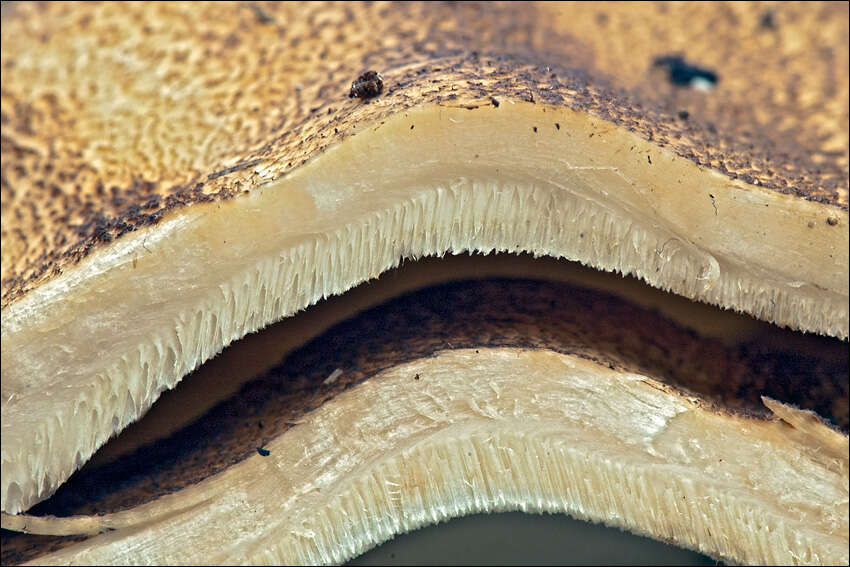
Meripilus giganteusGiant PolyporeSlo.: rnea velezraenkaDat.: Sept. 19. 2013Lat.: 46.33515 Long.: 13.56790Code: Bot_750/2013_DSC0349Habitat: Light, mixed, predominantly hardwood woodland, dominant Fagus sylvatica, Picea abies, Quercus sp., Fraxinus excelsior, Corylus avellana; nearly flat terrain, cretaceous clastic rock (flysh), partly rain protected by trees canopies, mostly in shade, precipitations ~3.000 mm/year, average temperature 8-10 deg C, elevation 480 m (1.575feet), alpine phytogeographical region.Substratum: a large stump and roots of a cut down tree in its final stage of disintegration; tree species undistinguishable; most probably Fagus sylvatica, but possibly also Quercus sp. (several trees growing in the vicinity).Place: Bovec basin, Humi hill, East Julian Alps, Posoje, Slovenia EC Comments: Growing solitary (probably a single mycelium), however in three groups of pilei on the same tree; they were about 1 m (3 feet) apart, the largest group about 40 cm (16 inch) in diameter; taste strong, mushroomy, unpleasant; smell slightly unpleasant, indistinctive; flesh strongly fibrous; SP whitish; pore surface bruising when handled, first ochre, then brown, then blackish, but not fast, the process takes several ten minutes.Spores smooth. Dimensions: 5.7 (SD= 0.3) x 4.8 (SD= 0.2) , Q= 1.2 (SD= 0.06), n= 30. Olympus CH20, NEA 100x/1.25, magnification 1.000 x, oil, in water.AmScope MA500 digital camera.Herbarium: Mycotheca and lichen herbarium (LJU-Li) of Slovenian Forestry Institute, Vena pot 2, Ljubljana, Index Herbariorum LJFRef.:(1) S.Buczacki, Collins Fungi Guide, Collins (2012), p 505.(2) R.Phillips, Mushrooms, Macmillan (2006), p 301.(3) G.J.Krieglsteiner (Hrsg.), Die Grosspilze Baden-Wrttembergs, Band 1, Ulmer (2000), p 547. (4) M.Bon, Parey'sBuch der Pilze, Kosmos (2005), p 314. (5) R.Lueder, Grundkurs Pilzbestimmung, Quelle& Meyer (2008), p 338.(6). Daehncke, 1200 Pilze in Farbfotos, AT Verlag (2009), p 1065.
-
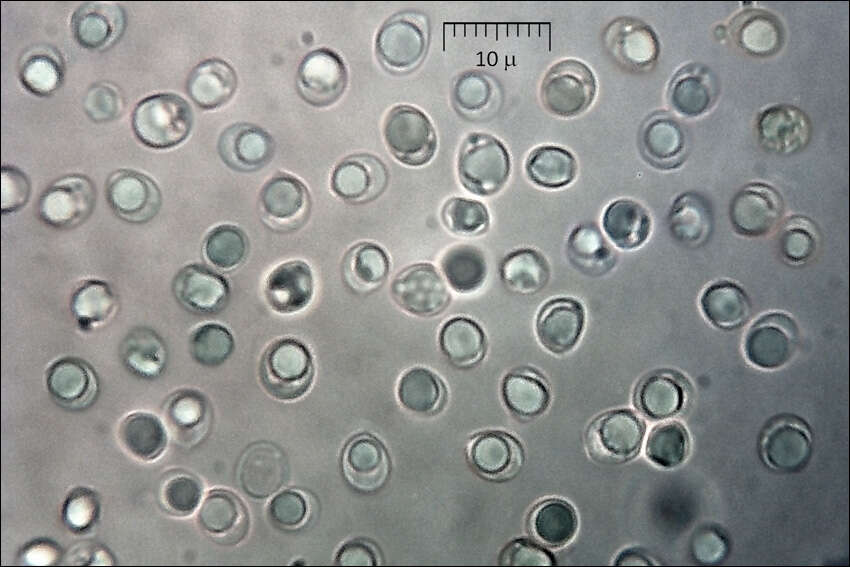
Meripilus giganteusGiant PolyporeSlo.: rnea velezraenkaDat.: Sept. 19. 2013Lat.: 46.33515 Long.: 13.56790Code: Bot_750/2013_DSC0349Habitat: Light, mixed, predominantly hardwood woodland, dominant Fagus sylvatica, Picea abies, Quercus sp., Fraxinus excelsior, Corylus avellana; nearly flat terrain, cretaceous clastic rock (flysh), partly rain protected by trees canopies, mostly in shade, precipitations ~3.000 mm/year, average temperature 8-10 deg C, elevation 480 m (1.575feet), alpine phytogeographical region.Substratum: a large stump and roots of a cut down tree in its final stage of disintegration; tree species undistinguishable; most probably Fagus sylvatica, but possibly also Quercus sp. (several trees growing in the vicinity).Place: Bovec basin, Humi hill, East Julian Alps, Posoje, Slovenia EC Comments: Growing solitary (probably a single mycelium), however in three groups of pilei on the same tree; they were about 1 m (3 feet) apart, the largest group about 40 cm (16 inch) in diameter; taste strong, mushroomy, unpleasant; smell slightly unpleasant, indistinctive; flesh strongly fibrous; SP whitish; pore surface bruising when handled, first ochre, then brown, then blackish, but not fast, the process takes several ten minutes.Spores smooth. Dimensions: 5.7 (SD= 0.3) x 4.8 (SD= 0.2) , Q= 1.2 (SD= 0.06), n= 30. Olympus CH20, NEA 100x/1.25, magnification 1.000 x, oil, in water.AmScope MA500 digital camera.Herbarium: Mycotheca and lichen herbarium (LJU-Li) of Slovenian Forestry Institute, Vena pot 2, Ljubljana, Index Herbariorum LJFRef.:(1) S.Buczacki, Collins Fungi Guide, Collins (2012), p 505.(2) R.Phillips, Mushrooms, Macmillan (2006), p 301.(3) G.J.Krieglsteiner (Hrsg.), Die Grosspilze Baden-Wrttembergs, Band 1, Ulmer (2000), p 547. (4) M.Bon, Parey'sBuch der Pilze, Kosmos (2005), p 314. (5) R.Lueder, Grundkurs Pilzbestimmung, Quelle& Meyer (2008), p 338.(6). Daehncke, 1200 Pilze in Farbfotos, AT Verlag (2009), p 1065.
-
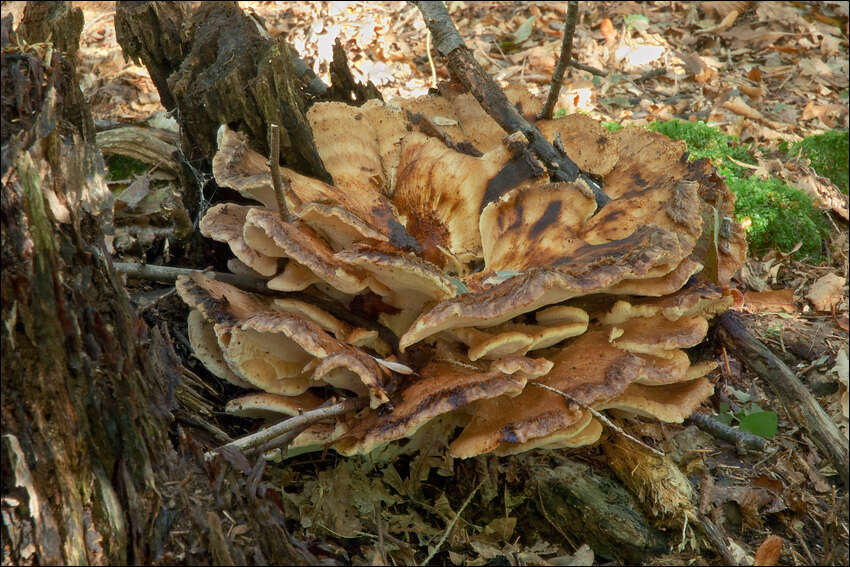
Meripilus giganteusGiant PolyporeSlo.: rnea velezraenkaDat.: Sept. 19. 2013Lat.: 46.33515 Long.: 13.56790Code: Bot_750/2013_DSC0349Habitat: Light, mixed, predominantly hardwood woodland, dominant Fagus sylvatica, Picea abies, Quercus sp., Fraxinus excelsior, Corylus avellana; nearly flat terrain, cretaceous clastic rock (flysh), partly rain protected by trees canopies, mostly in shade, precipitations ~3.000 mm/year, average temperature 8-10 deg C, elevation 480 m (1.575feet), alpine phytogeographical region.Substratum: a large stump and roots of a cut down tree in its final stage of disintegration; tree species undistinguishable; most probably Fagus sylvatica, but possibly also Quercus sp. (several trees growing in the vicinity).Place: Bovec basin, Humi hill, East Julian Alps, Posoje, Slovenia EC Comments: Growing solitary (probably a single mycelium), however in three groups of pilei on the same tree; they were about 1 m (3 feet) apart, the largest group about 40 cm (16 inch) in diameter; taste strong, mushroomy, unpleasant; smell slightly unpleasant, indistinctive; flesh strongly fibrous; SP whitish; pore surface bruising when handled, first ochre, then brown, then blackish, but not fast, the process takes several ten minutes.Spores smooth. Dimensions: 5.7 (SD= 0.3) x 4.8 (SD= 0.2) , Q= 1.2 (SD= 0.06), n= 30. Olympus CH20, NEA 100x/1.25, magnification 1.000 x, oil, in water.AmScope MA500 digital camera.Herbarium: Mycotheca and lichen herbarium (LJU-Li) of Slovenian Forestry Institute, Vena pot 2, Ljubljana, Index Herbariorum LJFRef.:(1) S.Buczacki, Collins Fungi Guide, Collins (2012), p 505.(2) R.Phillips, Mushrooms, Macmillan (2006), p 301.(3) G.J.Krieglsteiner (Hrsg.), Die Grosspilze Baden-Wrttembergs, Band 1, Ulmer (2000), p 547. (4) M.Bon, Parey'sBuch der Pilze, Kosmos (2005), p 314. (5) R.Lueder, Grundkurs Pilzbestimmung, Quelle& Meyer (2008), p 338.(6). Daehncke, 1200 Pilze in Farbfotos, AT Verlag (2009), p 1065.


